ACR Electronics ACR-PLB100 Personal Locator Beacon User Manual y1030155 t1
ACR Electronics, Inc. Personal Locator Beacon y1030155 t1
Instruction Manual
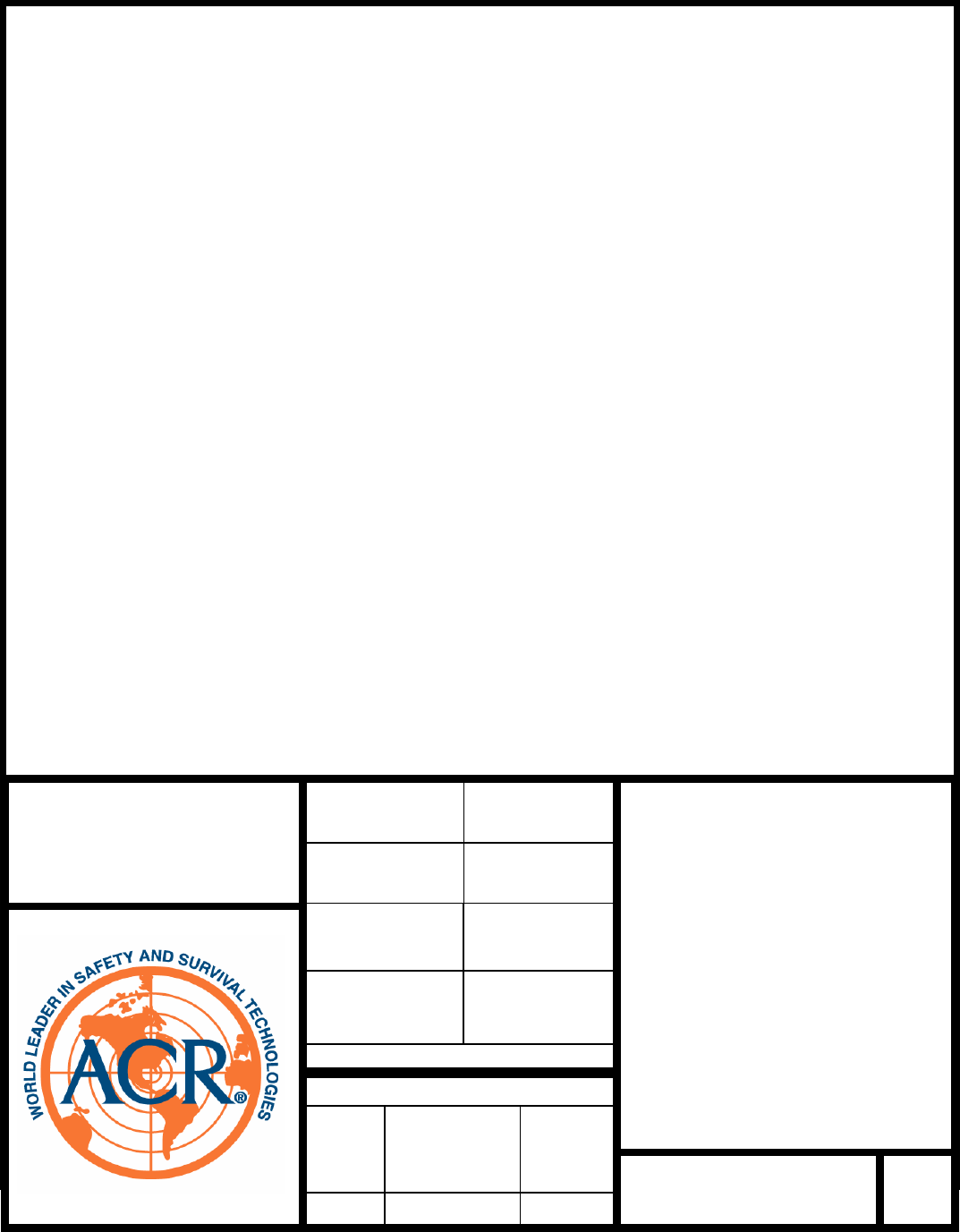
DRAWN.
Bill Cox
DATE.
4/9/2003
ACR ELECTRONICS INC
5757 Ravenswood Road
FT. Lauderdale Fl.
(954) 981-3333
CHECKED.
DATE.
ENG
Bill Cox
DATE.
4/9/2003
APVD
DATE.
Instruction
Manual
PLB-100
A
18560
Cover
Sheet
DRAWING NO
APPENDIX 2
REV
A
APPENDIX
2
Instruction Manual
FCC ID: B66-ACR-PLB100
Type acceptance under Part 95 Subpart K
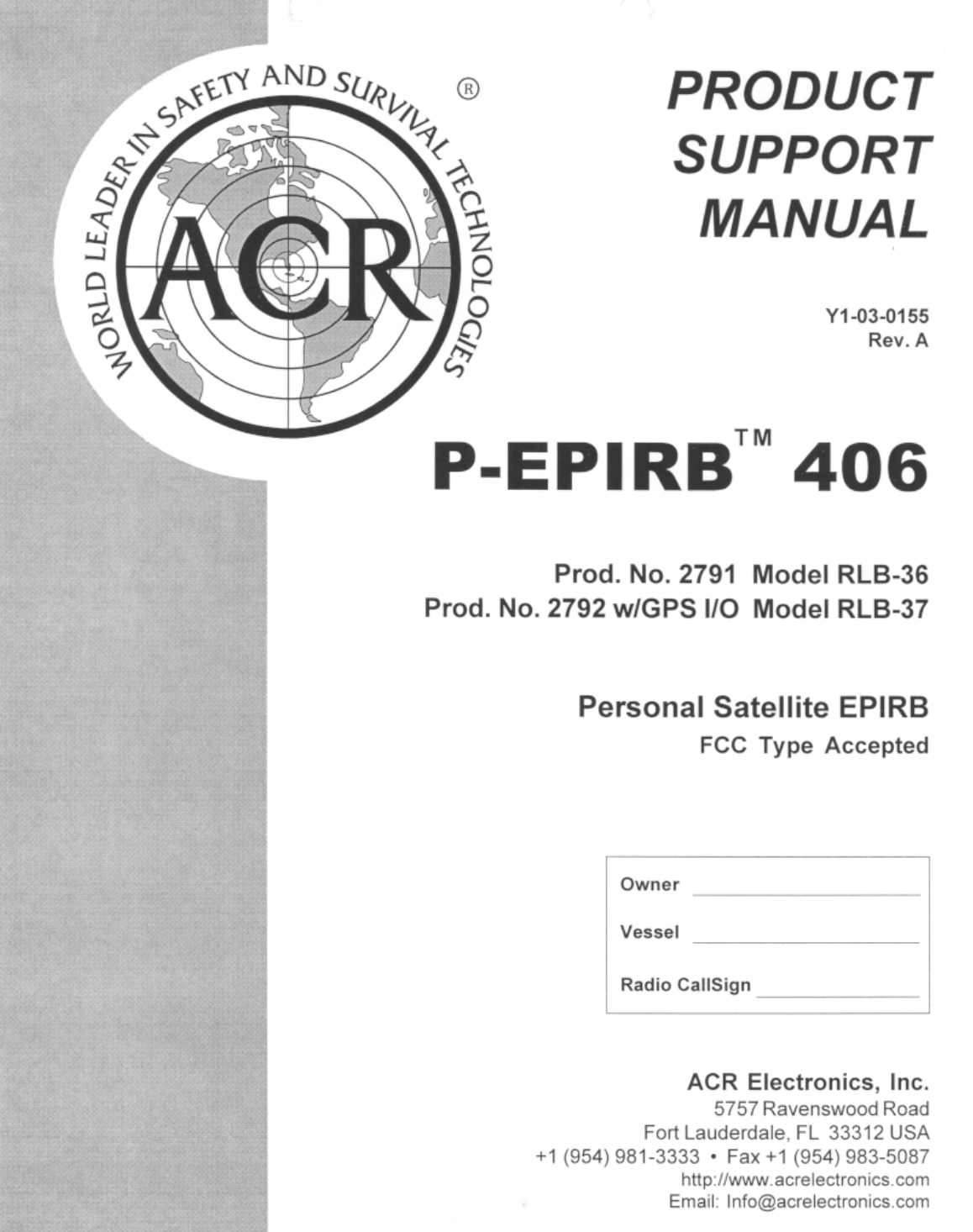

* * * WARNING * * *
THIS TRANSMITTER IS AUTHORIZED FOR USE
ONLY DURING SITUATIONS OF GRAVE
AND IMMINENT DANGER
DELIBERATE MISUSE MAY RESULT IN A SEVERE PENALTY
Advice to owners of Personal Satellite EPIRBs
Registration of 406 MHz satellite P-EPIRB with the Registration Section of the national authority* is mandatory
because of the global alerting nature of the system.
The information provided in the Registration Card is used only for rescue purposes and will greatly assist in any
beacon alarm incident.
Fill in the owner registration card immediately upon completion of the sales transaction. Immediately Mail the
Registration Card.
If the beacon is to enter service immediately, complete the Registration Card and fax the information to the national
authority. The original card must still be mailed to the national authority* for hard-copy reference and filing.
If the current owner is transferring the beacon to a new owner, the current owner is required to inform the national
authority* by letter, facsimile or telephone, of the name and address of the new owner.
The subsequent owner of the beacon is required to provide the national authority* with the information as shown on
the owner Registration Card.
Additional Registration Cards may be obtained by contacting ACR or the appropriate national authority.
THIS OBLIGATION TRANSFERS TO ALL SUBSEQUENT OWNERS.
*National Authority
The term “national authority” appears throughout this manual. Wherever these words appear, reference is made to
the government body responsible for registration for the country in which the unit is registered. The addresses for
various national authorities can be found on the Registration Card.
Y1-03-0155 Rev. A
1
TABLE OF CONTENTS
SECTION 1 - THE SYSTEM........................................................................................................ 2
1.1 General........................................................................................................................................... 2
1.2 Purpose........................................................................................................................................... 2
1.3 Satellite Detection.......................................................................................................................... 3
1.4 Authorizations ............................................................................................................................... 5
1.5 Characteristics............................................................................................................................... 5
1.6 Technical Data............................................................................................................................... 5
1.6.1 Applicable Documents.......................................................................................................................... 5
1.6.2 Specifications........................................................................................................................................ 5
SECTION 2 - OPERATION........................................................................................................ 10
2.1 General......................................................................................................................................... 10
2.2 P-EPIRB™ 406 Operating Instructions .................................................................................. 10
2.2.1 Activation............................................................................................................................................ 10
2.2.2 Deactivation........................................................................................................................................ 10
2.2.3 Self Test.............................................................................................................................................. 11
SECTION 3 - EXTERNAL GPS I/R ADAPTER....................................................................... 12
3.1 General......................................................................................................................................... 12
3.2 GPS Adapter................................................................................................................................ 12
3.2.1 Connecting:......................................................................................................................................... 12
3.2.2 Setup: .................................................................................................................................................. 13
3.2.3 Testing: ............................................................................................................................................... 13
3.2.4 Position data set to default: ................................................................................................................. 14
4.0 MAINTENANCE ........................................................................................................................ 14
5.0 REGISTRATION........................................................................................................................ 15
6.0 FALSE ALARMS........................................................................................................................ 15
Figure 1 – GEOSAR Satellite Coverage ..........................................................................4
Figure 2 – SAR Satellite Coverage ...................................................................................4
Figure 3 – Block Diagram ................................................................................................ 6
Figure 4 – Known Compatible GPS Receiver's........................................................... 7-9
Figure 5 – Self test............................................................................................................11
Figure 6 – Operating Position.........................................................................................12
Figure 7 – GPS Adapter Illustration..............................................................................13
Figure 8 – External GPS I/R Cable................................................................................14
Figure 9 - Basic Concept of the (COSPAS-SARSAT) System .....................................16

Y1-03-0155 Rev. A
2
SECTION 1 - THE SYSTEM
1.1 GENERAL 1.1
1.1.1 This manual provides operation and maintenance instructions for the P-EPIRB™ 406,
Personal Satellite EPIRB, model RLB-36 hereinafter referred to as the beacon or unit.
This section describes the characteristics and details of the P-EPIRB™ 406 system.
1.2 PURPOSE 1.2
1.2.1 The beacon provides distress alerting via radio transmission on 406 MHz to satellites of
the COSPAS-SARSAT network. The unit can also transmit a distress alert to the
GEOSAR network that includes GPS latitude and longitude coordinates that are inputted
through an I/R Interface that connects to the data output of a GPS Receiver.
1.2.2 The message transmitted by the beacon is unique for each unit, which provides
identification of the transmitter through computer access of registration files maintained
by the National Authority. It is the user's responsibility to fill out and mail the
enclosed registration form to the appropriate agency of the country under which the
beacon is registered. The beacon is programmed by ACR during manufacture and can be
reprogrammed by an ACR authorized programming facility for the registered country.
Remember, if your beacon is not registered, SAR Authorities do not know who you
are, where you live or where to contact anyone who might know anything about your
situation.
1.2.3 Once Search and Rescue (SAR) forces are alerted by the units signal (406 MHz), relayed
through the COSPAS-SARSAT and/or GEOSAR network, they can converge on the
position estimated by the satellite. With GPS data in the message SAR authorities can
know your precise location and speed up reaction time. Intermediate and short range
location is aided by the unit with its on board radio beacon homing signal transmitter
(121.5 MHz).
1.2.4 Power is provided by a self-contained long life battery pack that has a recommended 5-
year replacement cycle. See Factory Authorized Service Center for replacement (Section
4.0 – Maintenance).
1.2.5 Self-test (Section 2.5) is initiated by momentarily lifting the switch to the test position
(vertical stance) then releasing back to original position. During self-test, an actual
satellite message is transmitted and certain key performance parameters are measured and
recorded. The self-test message is modified such that the satellite will not forward an alert
message during self-test. The LED will flash 3 times amber before turning green. During
this time the unit will also beep 3 times to indicate correct operational status.
Approximately 2 seconds after self-test the unit will beep and the amber LED will flash to
indicate if the unit has GPS data.
Y1-03-0155 Rev. A
3
1.3 SATELLITE DETECTION
1.3.1 The beacon transmits an encoded phase modulated radio signal to the SAR satellite
portion of the COSPAS-SARSAT System. The system was developed and implemented
by the COSPAS-SARSAT Partners (Russian Federation, Canada, France and the United
States).
1.3.2 COSPAS-SARSAT is an international system that uses Russian Federation and United
States low altitude, near polar orbiting satellites that assist in detecting and locating
activated 121.5/243 MHz and 406 MHz Satellite beacons. The Russian Federation
provides aboard COSMOS navigational spacecraft COSPAS payloads that are inter-
operable with the SARSAT System. In addition to weather and environmental sensors,
SARSAT payloads, provided by Canada and France, are carried aboard the United States
National Oceanic and Atmospheric Administration’s (NOAA) Advanced TIROS
environmental satellites.
1.3.3 COSPAS and SARSAT satellites receive distress signals from the beacon transmitting on
the frequency of 406 MHz. The COSPAS-SARSAT 406 MHz satellite signal consists of
a transmission of non-modulated carrier followed by a digital message format that
provides identification data for SAR authorities. The 406 MHz system uses spacecraft-
borne equipment to measure and store the Doppler-shifted frequency data along with the
satellite digital data message including GPS data, and time of measurement to identify
your position. This information is transmitted in real time to an earth station called the
Local User Terminal (LUT), which may be within the view of the satellite, as well as
being stored for later transmission to other LUTs. In the real-time mode, the signal
detection is limited to a mutual satellite-LUT circular visibility area of about 2500 km
radius that moves with the satellite along its track. However, because of the stored-mode
capability at 406 MHz, the need for this mutual satellite-LUT visibility is not essential,
and the system is fully functional in just the global mode.
1.3.4 The LUT processes the Doppler-shifted signal and determines the location of the distress
signal; then the LUT relays the position of the distress signal to a Mission Control Center
(MCC) where the distress alert and GPS location information is immediately forwarded
to an appropriate Rescue Coordination Center (RCC). The RCC dispatches Search and
Rescue (SAR) forces.
1.3.5 The COSPAS-SARSAT System includes 36 LEOSAR LUT Stations, 6 GEOSAR LUT
stations and 19 Mission Control Centers that provide real-time as well as global-mode
coverage for the Northern Hemisphere, while the Southern Hemisphere is presently
served primarily by the global-mode. Additional LUTs and MCCs are planned for
installation in the near future both in the northern and southern hemispheres.
The addition of the GEOSAR Satellite system greatly improves the reaction time for a
SAR event. This satellite system has no Doppler capabilities at 406 but will relay the
distress alert to any of the LUT stations. When there is GPS data included in the distress
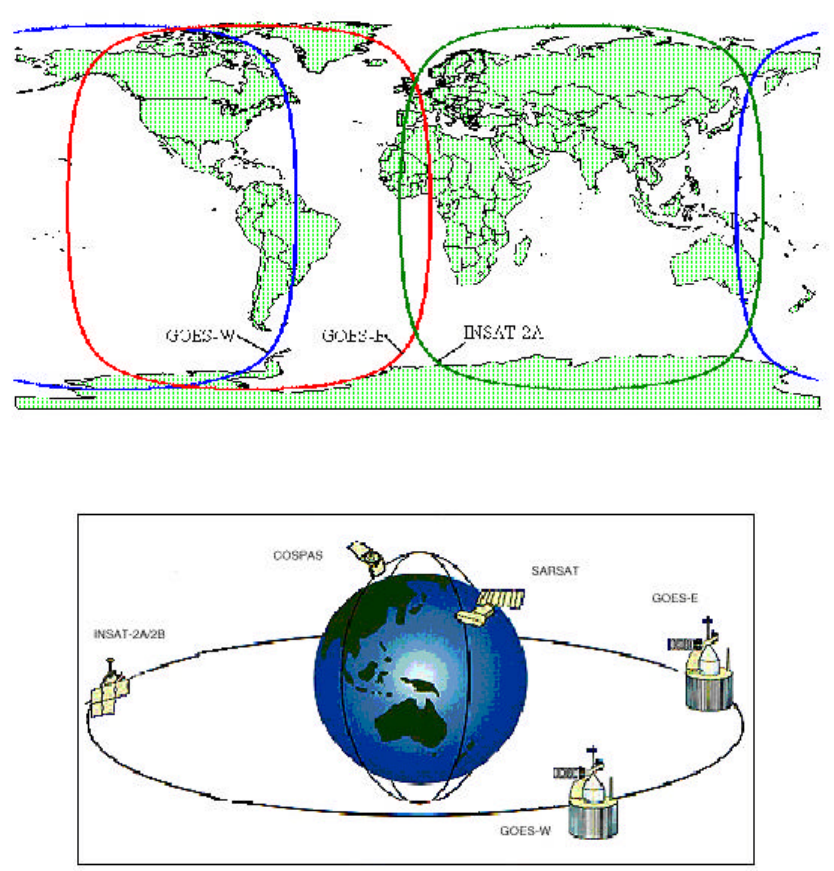
Y1-03-0155 Rev. A
4
message this will instantly tell SAR authorities where you are located. Hence speeding
up the reaction time by not having to wait for one of the LEOSAR satellite's to come
around.
GEOSAR SATELLITE COVERAGE
FIGURE 1
SAR SATELLITE ORBITS
FIGURE 2
1.3.6 Because most of the search and rescue forces presently are not equipped to home on the
406 MHz Satellite signal, homing must be accomplished at 121.5 MHz.
1.3.7 The P-EPIRB™ 406 is a Class 1, P-EPIRB.

Y1-03-0155 Rev. A
5
1.4 AUTHORIZATIONS
1.4.1 The P-EPIRB™ 406 meets the requirements of the RTCM version 1:1997 for PLB’s, and
Cospas/Sarsat T.001 & T.007.
1.5 CHARACTERISTICS
1.5.1 The beacon is a floatable; battery operated unit that accepts external GPS data via an I/R
interface cable that is included with your unit. The beacon case, with its external antenna,
is waterproof. The semiconductor circuits are mounted within the case assembly along
with the battery power supply. A “On/Off” switch is installed on top of the beacon, along
with an internal beeper.
1.6 TECHNICAL DATA
1.7
1.6.1 Applicable Documents
COSPAS-SARSAT Document C/S T.001 & T.007 (specification for 406
MHz distress beacons)
RTCM RTCM Version 1.0 1997
1.6.2 Specifications
406 MHz Transmitter
Frequency 406.025 MHz
Frequency Stability ±2 parts per billion/100ms
Output Power 5 watts
Digital Message
Format
Long message / serialized
Message protocol Standard Location or optional National location
Protocol
Duration 520 ms
Rate 400 BPS
Encoding Biphase L
Modulation ±1.1 radians peak
The unit leaves ACR with a serialized code but can be reprogrammed at a service center
to other coded formats including country of registration.
121.5 MHz Transmitter
Frequency 121.5 MHz
Frequency Tolerance ±50 ppm
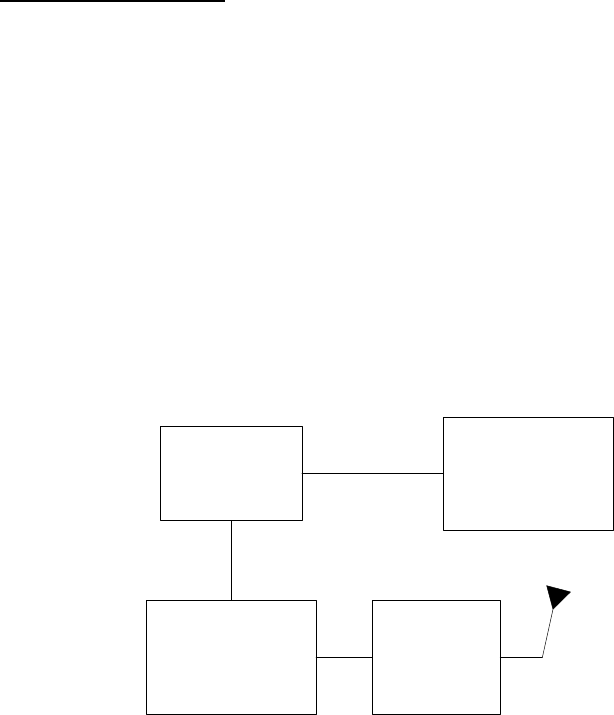
Y1-03-0155 Rev. A
6
Output Power 25 mW PEP
Modulation
Type AM (3K20A3N)
Sweep Range 400 to 1200 Hz
Sweep Rate 3 Hz
Duty Cycle 37.5%
Antenna
Frequency 406.025 & 121.500 MHz
Polarization Vertical
VSWR Less than 1.5/1
General/Environmental
Battery Life
Operating 24 hours minimum @ -40°C
Replacement Interval 5 years
Size
Unit less Antenna 6.65 x 3.55 inches
Material High impact and UV resistant plastic Color High
Visibility Yellow
Weight 514 grams
Temperature Range
Operating Class I -40°C to +55°C
BLOCK DIAGRAM
FIGURE 3
USER /
PROGRAMMING
INTERFACE
MCP
406 / 121.5 MHz RF
AMPLIFIER

Y1-03-0155 Rev. A
7
KNOWN COMPATIBLE RECEIVERS
Manufacturer Model Notes Y2K and EOW Compliant
B&G Network LCD Plotter / DGPS *Yes
B&G Network LCD Plotter / GPS *Yes
B&G Network GPS and DGPS *Yes
B&G Network GPS *Yes
Data Marine Chartlink D7000 XT *Yes
Data Marine Chartlink D7000 XTC *Yes
Data Marine Chartlink II D8000 *Yes
Data Marine Link D3500 *Yes
Data Marine Link D3500 LD *Yes
Furuno GP1810F *Yes
Furuno GP1810 *Yes
Furuno GP1610C *Yes
Furuno GP1600F *Yes
Furuno GP1600 *Yes
Furuno GP30 *Yes
Furuno GP35 *Yes
Garmin 10 *Yes
Garmin 12 *Yes
Garmin 20 *Yes
Garmin 25 *Yes
Garmin 30 *Yes
Garmin 31 *Yes
Garmin 35 *Yes
Garmin 36 *Yes
Garmin 38 *Yes
Garmin 40 *Yes
Garmin 45 *Yes
Garmin 48 *Yes
Garmin 50 *Yes
Garmin 75 *Yes
Garmin 85 *Yes
Garmin 89 *Yes
Garmin 90 *Yes
Garmin 92 *Yes
Garmin 95 *Yes
Garmin 120 *Yes
Garmin 126 *Yes
Garmin 128 *Yes
Garmin 130 *Yes
Garmin 135 *Yes

Y1-03-0155 Rev. A
8
Manufacturer Model Notes Y2K and EOW Compliant
Garmin 175 *Yes
Garmin 180 *Yes
Garmin 185 *Yes
Garmin 190 *Yes
Garmin 195 *Yes
Garmin 210 *Yes
Garmin GPSMAP 215 *Yes
Garmin 220 *Yes
Garmin GPSMAP 225 *Yes
Garmin GPSMAP 230 *Yes
Garmin GPSMAP 235 SOUNDER *Yes
Garmin 120XL *Yes
Garmin 12XL *Yes
Garmin 45XL *Yes
Garmin 55AVD *Yes
Garmin 95XL *Yes
Garmin GPS II *Yes
Garmin GPS II+ *Yes
Garmin GPS III *Yes
Lowrance GlobalMap 12 *Yes
Lowrance GlobalMap 1600 *Yes
Lowrance GlobalMap Sport Some older versions of software
may not output GGA, contact
Manufacturer
Yes
Lowrance LMS-160 *Yes
Magellan GPS 2000 XL *Yes
Magellan GPS 3000 *Yes
Magellan GPS 3000 XL *Yes
Magellan GPS 4000 *Yes
Magellan GPS 4000XL *Yes
Magellan Meridian XL *Yes
Magellan Trailblazer *Yes
Magellan Trailblazer XL *Yes
Magellan White Meridian *Yes
NorthStar 941X *Yes
NorthStar 951X *Yes
NorthStar 961X *Yes
Raytheon Autohelm ST50 Plus GPS *Yes
Raytheon GPS-11 *Yes
Raytheon HSB Chart Plotter *Yes
Raytheon NavCenter 600 *Unit will display wrong time and date
after Y2K. Send unit to manufacturer
for upgrade
Raytheon Raychart 620 *Unit will display wrong time and date
after Y2K. Send unit to manufacturer
for upgrade
Raytheon RC-520 *Yes
Raytheon RL-70RC *Yes

Y1-03-0155 Rev. A
9
Manufacturer Model Notes Y2K and EOW Compliant
Si-Tex DGPS-11 *Yes
Si-Tex GPS-1 *Yes
Si-Tex GPS-10 *Yes
Si-Tex GPS-10A *Yes
Si-Tex GPS-4A *Yes
Si-Tex GPS-5 *Yes
Si-Tex GPS-6 *Yes
Si-Tex GPS-7 *Yes
Si-Tex GPS-77P *Yes
Si-Tex GPS-8 *Yes
Si-Tex GPS-88P *Yes
Si-Tex GPS-9 *Yes
Si-Tex GPS-99P *Yes
Si-Tex GPS-9D *Yes
Si-Tex HG-7 *Yes
Si-Tex SBR-90 *Yes
Si-Tex SBR-91 *Yes
Trimble 4000DSi *Firmware must be upgraded to V7.19
to comply
Trimble 4000RSi *Users of Firmware V7.15 - V7.18
must upgrade to V7.19. Users of
V7.28 must upgrade to V7.29. Users
of V7.29 are fully compliant
Trimble 7400MSi *Yes
Trimble MS750 *Yes
Trimble Navgraphic XL *N/A - No Date Output
Trimble NavMariner DGPS *Yes
Trimble NavTrac GPS *Version 2.09 is compliant. Earlier
versions are not being tested
Trimble NT200 *Yes
Trimble NT200D *Yes
Trimble NT300D *Yes
Trimble DSM *Yes for versions 1.10 and later
Trimble NT100 *Yes
GPS units compatible with ACR Beacons based on vendor information
(*) Indicates that unit complies with ACR requirements
Known Compatible GPS Receivers
FIGURE 4
SECTION 2 – OPERATION
2.1 GENERAL
2.1.1 The beacon is designed to be manually deployed and activated.
2.1.2 The beacon can accept NMEA 0183 GPS Data (Version 1.5 and above, the GGA
sentence string must be enabled) through its I/R interface. Data is updated every
30 minutes once an initial position is acquired.
2.1.3 The beacon is also designed to allow the user to perform periodic testing and
confirmation of GPS connection and downloaded coordinates.
2.1.4 The beacon checks for a valid GPS data approximately every 2 seconds if no
current valid data exists.
2.1.5 The beacon will update its GPS data by initiating the self-test function if data is
present.
2.1.6 The beacon will hold the last GPS coordinates in memory until the unit is
activated. After deactivating the unit, GPS data is returned to default.
2.2 OPERATING INSTRUCTIONS
2.2.1 Activation
Unfold Antenna from around unit and move Antenna to a Vertical position (See
Figure 6) Lift Switch to the "ON" Position by lifting up and sliding over then
down to "ON" to activate the unit. "ON" position is indicated by "y" on the face of
the switch. Your beacon comes with a Breakaway tab on the switch to keep from
accidental turn-on. PUSH SWITCH down to break TAB in case of an emergency.
Once activated the unit will; Beep and the RED LED will begin to flash one red
flash approximately every 20 seconds. Unit will send Rescue message approx.
every 50 seconds and will beep after each message that has been sent. Keep
beacon with you at all times.
2.2.2 Deactivation
Turning the switch to the “Off” position will deactivate the beacon.
If the beacon continues to operate after it has been deactivated, remove the two
screws at the bottom of the unit, and unplug the battery to disable the unit.
Return it to a service center for repair.
10
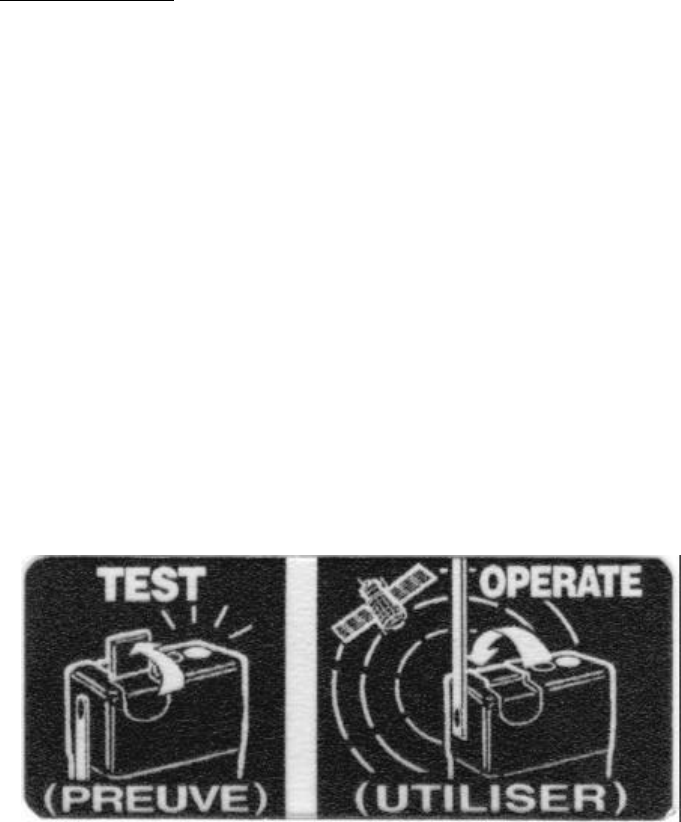
Y1-03-0155 Rev. A
11
2.2.3 Self Test
The beacon self-test is initiated by lifting the switch at the top of the unit to a
Vertical Position momentarily and releasing it back to the "Off" position. Switch
is spring loaded to return to the "Off" position.
Note: "Off" Position indicated by a "O" on switch face "ON" by "y", on the face
of the switch.
Upon lifting the switch, a very short yellow flash will indicate self-test has been
initiated then the following:
Sequence of Tests
1. Check Data I/O .........................................Beep & flash yellow LED if pass
...................................................................Stop if failed
2. Check 406 MHz Synthesizer.....................Beep & flash yellow LED if passed
...................................................................Stop if failed
3. Check RF Power/Battery...........................Beep & flash yellow LED if passed
...................................................................Stop if failed
4. Unit turns on green LED to indicate Successful Test.
5. Approximately 2 seconds after the LED flashes green it will flash amber and
beep if valid external GPS data has been received.
A successful test result is indicated by: a short beep then three beeps with three
yellowish flashes concurrently then the LED turns green for pass.
NOTE: The 121.5 MHz homing beacon is inhibited during self-test.
It is strongly recommended to test the beacon on a quarterly basis.
SELF TEST
FIGURE 5
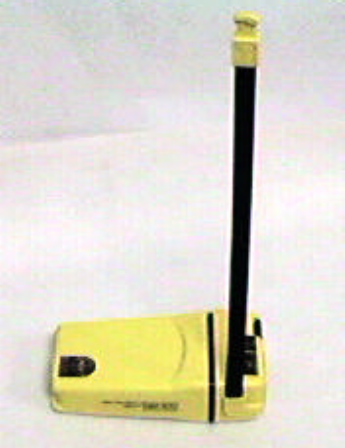
Y1-03-0155 Rev. A
12
OPERATING POSITION
FIGURE 6
SECTION 3 -EXTERNAL GPS I/R ADAPTER
3.1 GENERAL
Your unit comes with a GPS cable Plug Adapter that can be interfaced to your
GPS receiver to input actual GPS data into your beacon. This extra data can help
improve reaction time to your position in the event of an emergency. This data is
particularly helpful when the GEOSAR Satellite system picks up the Distress
Alert.
3.2 GPS ADAPTER
3.2.1 Connecting:
Your External GPS I/R cable attaches to your UNIT and the GPS receiver,
forming a Link for data to transfer. (Like a printer) The cable Plug’s into the
socket labeled GPS located at the top of the unit. The other end has two wires that
need to be connected to the GPS Receiver’s Data/Power Cable. Consult your GPS
Manual for wire identification.
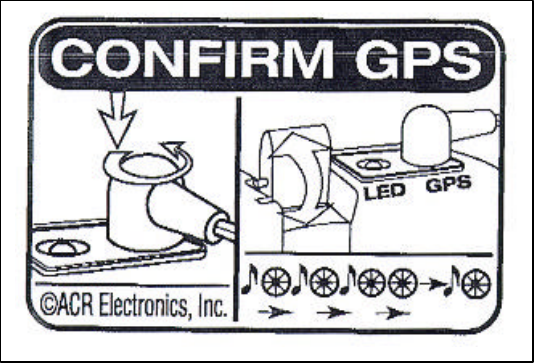
Y1-03-0155 Rev. A
13
The Data/Power cable for your GPS receiver typically has connections for an
external power source and data output. Ensure proper connection.
The External GPS adapter that is supplied with your UNIT has two wires that are
polarized. The wire with the white stripe on it is the + data lead and should be
connected to the + Data lead of your GPS Data/Power connector. The other lead
with no stripe is the - Data lead and should be connected to the - Data lead of your
GPS Data/Power Cable. Use an Epoxy type Heat shrink for weatherproofing
connection.
GPS ADAPTER ILLUSTRATION
FIGURE 7
3.2.2 Setup:
The Data protocol your beacon will be accepting is the NMEA 0183 Version 1.5
and above. Set baud rate to 4800 and the GGA sentence string needs to be
enabled. Some GPS receivers have options on what strings are enabled. Ensure
the GGA string is enabled. Consult your GPS manual for further information. This
is a very common standard for GPS receivers.
Check your cable to ensure that the polarity is correct for the + data and – data
leads. It will not work if polarity is wrong.
Your GPS receiver needs to be set to this data protocol for data transfer into the
beacon. If the beacon is not showing conformation of GPS data check, protocol,
baud-rate, ensure GGA string is enabled and cable is wired correctly.
See Figure 4 for known compatible GPS receivers. Consult your GPS manual for
proper data protocol settings.
3.2.3 Testing:
Plug the Adapter into the top of the UNIT into the socket labeled GPS.
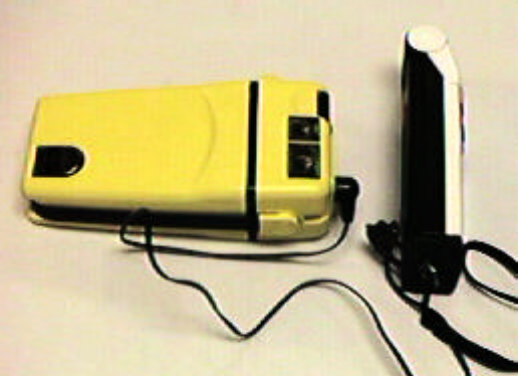
Y1-03-0155 Rev. A
14
Ensure your GPS has acquired a valid position. Momentarily lift the "ON/OFF"
switch to the self-test position and stand-by. The beacon will go through it’s self
test routine and approx. 2 seconds after the LED turns green the unit will beep
once and the Yellow LED will flash to indicate that valid GPS data has been
transferred into your UNIT. Repeat step 3.2.2 if no conformation.
The beacon will automatically up load new GPS position every 30 minutes if you
leave it connected to your GPS receiver.
When you activate self-test the beacon will start to look for new GPS data and
update accordingly, if no new data is present or cable is disconnected the original
data will still stay in memory.
Once data has been loaded into your UNIT it will remain there until the unit is
activated to the "ON" mode.
EXTERNAL GPS I/R CABLE
FIGURE 8
3.2.4 Default data:
Default data is when there is no GPS data in the unit. The beacon reverts to
default data once the unit has been activated and then shutoff. The unit will
function normally without GPS data.
4.0 MAINTENANCE

Y1-03-0155 Rev. A
15
4.1 Carefully inspect the unit’s case for any visible cracks. Cracks may admit
moisture, which could falsely activate the beacon or otherwise cause a
malfunction. Any cracking observed should be immediately referred to ACR or
nearest distributor for evaluation, (1-800-432-0227 Ext. 112) toll free in the USA.
4.2 The battery must be replaced by the date indicated on the beacon. At each
inspection, check the time remaining until replacement is required.
NOTE: There are no user serviceable items inside the unit. DO NOT OPEN THE
beacon UNLESS TO DISABLE IN CASE OF FAULTY ACTIVATION. Refer all
long life battery replacement and other internal unit service to a factory authorized
service center. For the nearest location of a factory authorized service center, call
1-800-432-0227 Ext. 112 (toll free in the USA) or +1 (954) 981-3333, Ext. 112.
It is strongly recommended to test the beacon on a quarterly basis.
5.0 REGISTRATION
5.1 It is imperative that this unit is registered with NOAA (National Oceanic
Atmospheric Administration) if used in the USA or with your own national
authority accordingly. The beacon has been programmed with a unique
identification number or code which is broadcast on 406 MHz. Registration with
the appropriate national authority provides the Search and Rescue people with
important information which will speed up the rescue operation and minimize
false alarms.
5.2 To register this unit with NOAA, simply fill out and mail the provided form in the
enclosed pre-addressed envelope to NOAA or FAX the completed form to (301)
457-5406.
5.3 NOAA will supply a beacon registration decal, which is to be affixed to the unit.
6.0 FALSE ALARMS
6.1 Should there be, an inadvertent activation or false alarm, it must be reported to the
nearest search and rescue authorities. The information that should be reported
includes the units Unique Identifier Number (UIN); date, time, duration, and
cause of activation; and the location at the time of activation. Information is
located on the label.
6.2 Contact the appropriate national authority to report false alarms
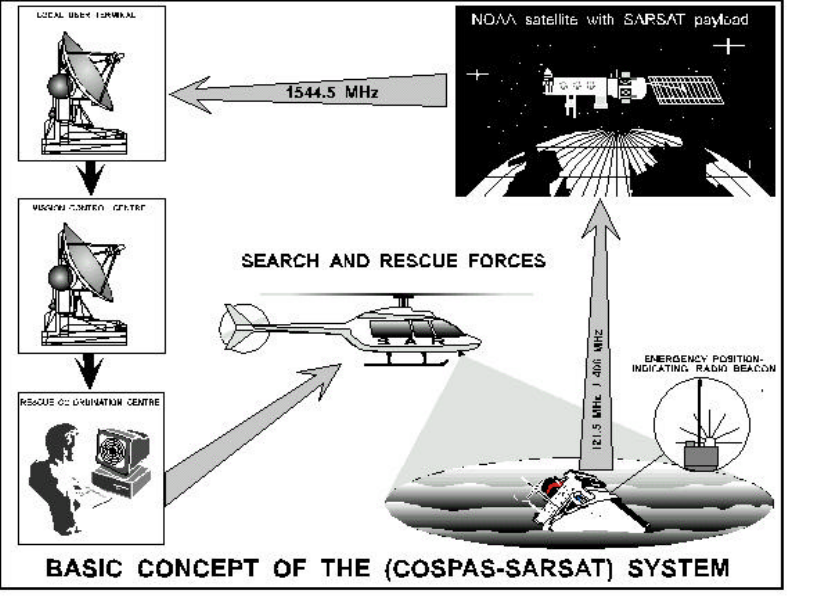
Y1-03-0155 Rev. A
16
***WARNING***
THIS TRANSMITTER IS AUTHORIZED FOR USE
ONLY DURING SITUATIONS OF GRAVE
AND IMMINENT DANGER!
FIGURE 9